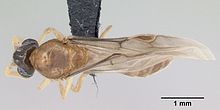Dracula ant
| Adetomyrma | |
|---|---|
 |
|
| A blind A. venatrix worker | |
 |
|
| A winged A. venatrix queen | |
| Scientific classification | |
| Kingdom: | Animalia |
| Phylum: | Arthropoda |
| Class: | Insecta |
| Order: | Hymenoptera |
| Family: | Formicidae |
| Subfamily: | Amblyoponinae |
| Tribe: | Amblyoponini |
| Genus: |
Adetomyrma Ward, 1994 |
| Type species | |
|
Adetomyrma venatrix |
|
| Diversity | |
| 9 species | |
Adetomyrma is a genus of ants endemic to Madagascar. Workers of this genus are blind. The type species Adetomyrma venatrix was described in 1994, with the genus being an atypical member of its tribe, the Amblyoponini. This tribe includes the dracula ants, members of which feed on the hemolymph of larvae.
Adetomyrma was first described as a Malagasy endemic monotypic genus by Ward in 1994. Ward (1994) assigned this genus to Amblyoponini within the subfamily Ponerinae on the basis of the worker morphology of the type species Adetomyrma venatrix. Later, Bolton (2003) raised this tribe to subfamily status as Amblyoponinae.
Members of the Amblyoponinae (especially Amblypone silvestrii) are called Dracula ants, after Count Dracula, the fictional vampire, referring to their unusual feeding habits; queens and workers practice a form of "non-destructive cannibalism", chewing holes into and feeding on the haemolymph (insect "blood") of the colony's own larvae. This behaviour, termed larval hemolymph feeding is thought to represent a precursor to trophallaxis, found in more derived ant species.
The colonies, the first of which was found in a rotting log, may contain as many as 10,000 workers, winged males and several wingless queens (the majority of ant species feature winged queens). The workers use venom to stun their prey which are brought back to the colony for the larvae to feed upon. The colour of the winged males, a darker orange than the workers, suggests they disperse by flying to other colonies before mating.
...
Wikipedia
